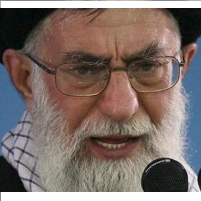Sorting Through the Facts in the Iranian Election
Tuesday, June 16, 2009
 Ayatollah Ali Khamenei, the real ruler of Iran
Ayatollah Ali Khamenei, the real ruler of Iran
Every year I write an article for Parade magazine about The World’s Worst Dictators, and every year I rank Iran’s Ayatollah Ali Khamenei among the 10 worst. Clearly, I am rooting for the current Iranian regime to fall and be replaced by a democratic government that respects basic freedoms. However, I am troubled by some of the U.S. media coverage of the current crisis in Iran, well-meaning though it may be. So here are a few factual clarifications.
Presidential Elections in Iran are Meaningless
You’d never know it from most of the coverage, but the Iranians did elect a reformist president, Mohammad Khatami, twice in the last 12 years. He won the 1997 election with 69% of the vote and he was reelected in 2001 with 78% of the vote. Iranians also overwhelmingly voted into power a reformist legislature (known as the Majlis) in 2000. Over the next couple years the Majlis passed bills that promoted democracy and human rights, and Khatami signed them. But none of them became law. That’s because the Iranian constitution allows the 12-member Guardian Council of religious leaders and its Leader, Ayatollah Khamenei, to veto any laws passed by the elected government. For all the attention given to the president of Iran, Mahmoud Ahmadinejad, he is really just a powerless figurehead chosen by Khamenei and the Guardian Council to deflect attention away from the real rulers of Iran.
It has been exciting to follow the attempts of the Iranian people to elect another reformist president, Mir-Hossein Mousavi, but in terms of altering who is in charge in Iran, the election was no more relevant than a contest between Adam Lambert and Kris Allen.
This Week’s Protests are Probably Not the Largest since the 1979 Revolution
Again, it has been uplifting to watch the Iranian people defy authority and take to the streets in huge numbers to protest the election results. Estimates have ranged from 100,000 marchers to “hundreds of thousands.” That’s an impressive turnout, but in July 1999, a peaceful, antiregime demonstration in Teheran drew an estimated 750,000 Iranians into the streets.
By Calling for a Partial Recount, Khamenei is not Showing Signs of Vulnerability
Ayatollah Khamenei is a smooth operator. Although he is more than willing to use violence to put down threats to his power, he would rather use tactics that appear to respond to criticism without actually doing so. For example, when the reformists dominated the 2000 legislative elections, Khamenei told supporters that “The two factions, the progressive and the faithful, are as necessary as the two wings of a bird.” Meanwhile, he shut down reformist publications and made sure that the newly elected Majlis would not be allowed to investigate any foundation that was under his protection.
The Guardian Council Decides Who is Allowed to Run
Iranian elections are not even as open as they appear to be because the Guardian Council is allowed to disqualify any candidate who registers to run for office. Prior to the 2008 Majlis elections, the Guardian Council rejected no less than 2,900 of 7.500 candidates. Needless to say, the majority of disqualified candidates were opposed to the regime.
-David Wallechinsky
- Top Stories
- Unusual News
- Where is the Money Going?
- Controversies
- U.S. and the World
- Appointments and Resignations
- Latest News
- Trump to Stop Deportations If…
- Trump Denounces World Series
- What If China Invaded the United States?
- Donald Trump Has a Mental Health Problem and It Has a Name
- Trump Goes on Renaming Frenzy






Comments